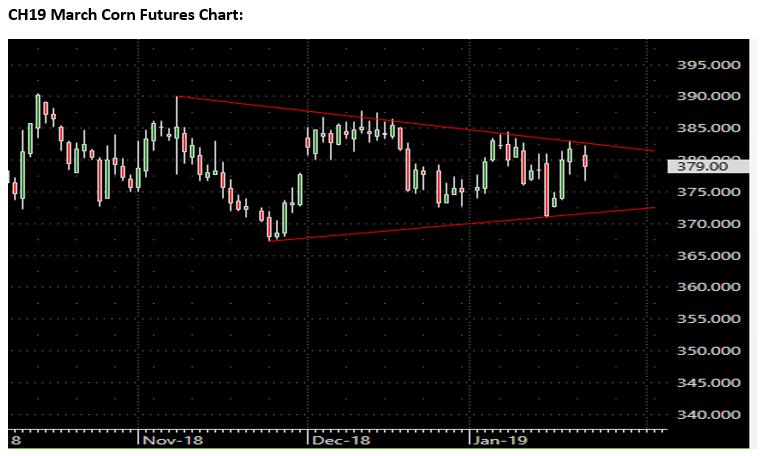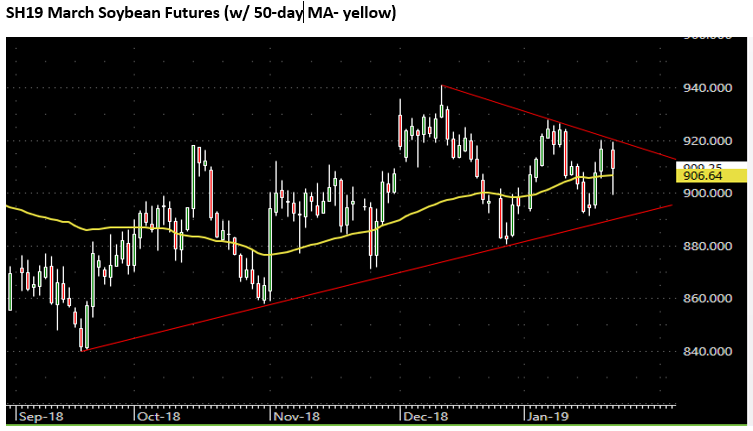Special Market Update
Grain Market Commentary
Tuesday, January 22, 2019
By Rhett Montgomery, Grain Associate, The Andersons
Corn
With the markets closed yesterday in observance of Martin Luther King Jr. Day, today was the first session of the week following a fairly strong finish to last week which saw the March board price pop up 10c in the latter half of the week. To start this week March corn (CH19) traded down 2.75c, closing at $3.79. For the month of January and so far for the year 2019, corn prices are up 3.75c. The market has been stuck in a 15 or so cent range for the past few months, consolidating even more so with the lack of fresh news from the USDA. The U.S. government shutdown hits the one-month mark today, and the corn market especially will need the release of new USDA numbers to spark any kind of extended move higher. It will be interesting to see if we ever get the January WASDE report which was due out on the 10th, and what adjustments the USDA will make, specifically when it comes to the final yield number which was expected to come in lower on the January report. On the demand side, recent strength can be attributed to steady to improving relations with China, and rumors swirling of a possible trade resolution coming soon. First was the rumor that the Trump administration was considering a drastic lift in many or all of the tariffs imposed on China. This rumor was quickly dispelled, and the latest rumor is that China’s proposition is $1 trillion worth of U.S. imports over the next 6 years in an attempt to close the trade deficit. This deal would surely include a great deal of agricultural products, including corn and ethanol.
Perhaps the biggest driver of corn price throughout the first months of 2019 will be the guessing game of how many acres will be planted this spring. Over the past couple of years, the U.S. has lost 5 mil. corn acres, while gaining near the same amount if not a touch more in soybean acres. It seems that the battle of acres will be decided more by the soybeans price movement rather than corn in the coming months. In other words, the overall feeling is that soybeans are overpriced given their fundamentals, but at current new crop futures in the upper $9.50 range, how many acres are being discouraged? And how many of those acres are switched to corn rather than a specialty grain? Just looking at corn and soybeans, from a pure profitability viewpoint corn seems to have the edge today. At current prices, using a $4.00 new crop futures price and I’ll use a typical Nebraska harvest corn basis of -40z19, gives us a $3.60 cash price. Using a yield of 195 bpa (Nebraska 2018 avg. yield) gives a gross revenue of $702/acre. Comparing that to soybeans, using a $9.60 November hedge and a new crop basis of -80x19 gives a cash price of $8.80. Using last year’s NE yield of 61 bpa, gives us $537/acre gross returns. Now, assuming that corn wins the battle and gains back 3 mil. acres this spring, looking at the U.S. balance sheet and keeping all demand factors the same while using a 177 bpa national average yield would leave us with a 2019/20 carryout again over 2B bushels and a stocks/use ratio of 14%, just a touch tighter than that of 2017/18, but up from where we sit currently at 12% for 2018/19. A stocks to use ratio of 14% can be associated with a U.S. farm price in the $3.25-$3.65 range. Keep in mind that this is keeping all things equal to 2018/19 values on the demand side, and how negotiations progress with China and the assurances that they will buy a substantial amount of U.S. Ag products could drastically alter this.
Overall, look for the market to remain range-bound until some of the many unknowns become known, whether this be a trade deal with China or the end of the government shutdown and the subsequent resumption of USDA report data. However, the market seems to have the potential of upside throughout the spring or summer if more demand shows itself or we are surprised with a plantings number only marginally higher or flat year over year.

Soybeans
March soybeans (SH19) closed at $9.0925 today, down 7.5c. For the month of January soybeans are up 15c. March futures today tested the $9.00 mark, trading as low as $8.99 before rebounding off the lows later in the session. Much like corn, soybeans benefited from a decent run up in price to end the week last week, being supported by rumors that the U.S. and China are progressing in trade talks. Weakness today can most likely be attributed to technical selling as the market finds itself stuck between trendline resistance and support from both the 50-day MA and a “psychological” $9.00 mark, as well as negative headlines regarding trade talks with China. The session today seemed indicative of the market as a whole the past several weeks. Up early, then down before rebounding off lows just shows the level of uncertainty and how volatile the market is to every news story regarding the trade war.
The biggest question in my mind right now when it comes to soybeans is assuming the trade dispute with China is resolved in the coming months, which is obviously a big assumption. How long does it take for traders to absorb/price in that bullish news before reality sets in of our 950+ million bushel carryout, in which we find ourselves in completely uncharted waters. The general feeling seems to be that soybeans are overpriced given these extremely bearish fundamentals. South American weather concerns have supported as well, but with that harvest around the corner, and China demand taking a hit from the onslaught of ASF, the U.S. and world balance sheets get rough with simply too much supply. Looking at the U.S. balance sheet, and assuming 3 mil or so less soybean acres from the corn discussion above, and penciling in a return to pre-tariff level exports in 2019/20, all other things equal still leaves us with another carryout north of 850mil bushels. Which begs the question of if the biggest loss in soybean acres may come in the 2020 planting seasons rather than this coming spring.
For now, the market continues to be held up by China trade rumors and South American weather, and contrary to corn the lack of USDA data, specifically export data, may be serving to prolong the upward trend in soybeans that has been in effect the past several months. However, sooner or later new USDA figures will be released, and it will be interesting to see how the market reacts when all the rumors and question marks for the demand story are either confirmed or unconfirmed, but the bearish supply of world soybeans seems likely to remain. For now, look for the choppy trade to continue, as each session’s trade seems likely to be driven primarily by that day’s trade war news.
